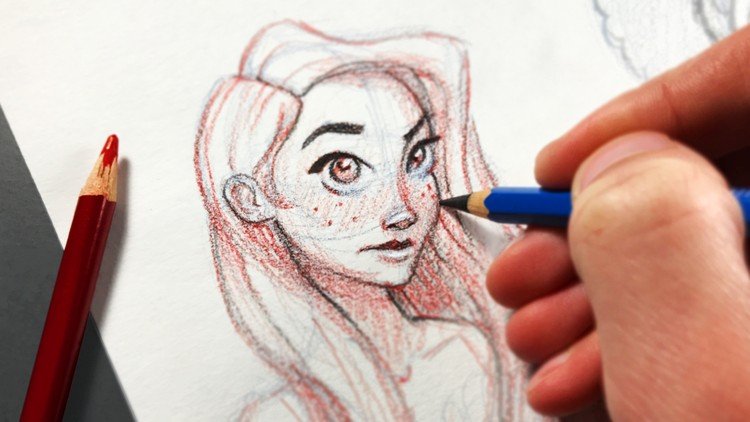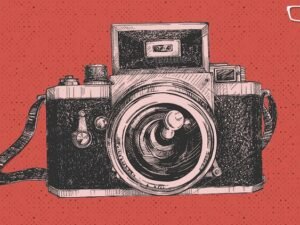- +91 844 9090 904
- info@maximumlearning.io
- Sector 62, Noida, 201309
- Description
- Curriculum
- FAQ
Join over 450,000 learning student and start gaining the drawing skills you’ve always wanted.
The
Ultimate Drawing Course will show you how to create advanced art that
will stand up as professional work. This course will enhance or give
you skills in the world of drawing – or your money back
The
course is your track to obtaining drawing skills like you always knew
you should have! Whether for your own projects or to draw for other
people.
This
course will take you from having little knowledge in drawing to
creating advanced art and having a deep understanding of drawing
fundamentals.
So
what else is in it for you?
You’ll
create over
50 different
projects in this course that will take you from beginner to expert!
You’ll
gain instant access to all 11 sections of the course.
The
course is setup to quickly take you through step by step, the process
of drawing in many different styles. It will equip you with the
knowledge to create stunning designs and illustration!
Don’t
believe me? I offer you a full money back guarantee within the first
30 days of purchasing the course.
Here’s
what you get with the course:
You’ll get access to the11 sections of the course that will teach you the fundamentals of drawing from the ground up. The course is supported with over 11 hours of clear content that I walk you through each step of the way.
All
at your fingers tips instantly.
-
The
course starts with the basics. You will get an in depth
understanding of the fundamentals of drawing. Fundamentals are the
most important part of creating professional art. You will learn
everything from line fundamentals all the way up to highlight and
shadows. -
Next
you’ll learn how perspective works and how to incorporate it into
your art. You will be learning 1, 2, and 3 point perspective. -
Once
you’ve learned perspective you are going to learn how to create
texture and apply it to your drawings. -
Then
you are going to learn how to draw from life. Observing life and
drawing it is a very important skill when it comes to art. -
At
this point you’ll be ready to start drawing the human face. We
will spend a whole section learning how to draw the human face from
different angles. -
Next
you’re going to learn how to draw the human figure. -
Lastly
you will gain access to the bonus section where I’ll teach you how
I draw animation styled characters step by step.
Over
the 7 chapters you will learn:
-
How
to draw an eye -
Line
fundamentals -
Shape
and form fundamental -
How
to use value and contrast -
Space
and perspective -
Still
life drawing -
Creating
texture -
Drawing
the human face -
Drawing
the human figure -
Drawing
animation styled art
What
else will you get?
– Personal contact with me and my teacher assistant.
–
Lifetime access to course materials
–
Understanding of how professional art is created
–
Quizzes and exercise work sheets
This all comes under one convenient easy to use platform. Plus you will get fast, friendly, responsive support on the Udemy Q&A section of the course.
So
what are you waiting for? Sign up now and
change your art world today!
Lear how to draw a realistic eye
-
1Introduction
Welcome to the course! I hope your ready to start creating some amazing artwork. In this lecture I'd like to introduce myself and tell you why I am qualified to be teaching drawing to you. Then we will do a quick overview of what is in store for you in this course!
-
2Helpfull links
-
3Learn how to get a guaranteed win out of this course!
My biggest problem with online courses is when an instructor gives me their course and leaves me at that. They don't give me any further assistance and I can't ask them questions. That's why I offer fully responsive support throughout the entire course. To get a guaranteed win out of this course be sure to ask all the questions you have and complete the course.
-
4Understanding the basics of drawing and the tools you will need
Before we beguine diving into the substance of this course I want to give you a brief over view of the basic fundamentals of drawing. By the end of this lecture you will have a basic understanding of each fundamental as well as the tools you will need to complete the course.
-
5Join the Artist Inner Family Facebook Group!
It's very important that during you learning process that you have a support group. That's why I have created The Artist Inner Family Facebook Group so you can have that support. In the group you will be able to post your artwork as well as ask for help and critiques. Make sure you join and I look forward to seeing your artwork!
-
6Join the Facebook support group and share your drawings!
Join the Facebook group and share your art with us as you go through the course. If you'd like critiques you can ask for them when you post. If not just expect some good old motivation from me and your fellow student!
-
7Learn why drawing is so important
Many people want to skip strait to painting amazing paintings or designing beautiful games but they forget to study the fundamentals. The fundamentals and the base of all art is drawing. In this lecture we will go over the importance of drawing and how this skill can benefit you in many different ways.
-
8Section 1 review Quiz
Let's do a quick review!
Learning line fundamental
-
9Drawing an eye - Step by Step
To start this courses first project off you are going to be drawing a realistic human eye. This may be a more advanced drawing but we are going to do it so we can test your drawing skills. Your first attempt may not look very good but at the end of the course you are going to redraw the same eye. When you compare the two you will notice a big difference after fully taking this course and doing the assignments.
-
10Adding the detail to your eye drawing
Now that you have the basic shapes and shading for your eye drawing it's time to get in there and start adding some real detail. In this lecture you will add in the hair on you eyebrows as well as the eyelashes. You will also start adding some darker values to your drawing such as the pupil and the eyelids.
-
11Download Your Printable Eye Drawing Instructions
Don't forget to download this cheat sheet on how to draw the human eye. This printable page is perfect if you're wanting to practice drawing the eye over and over again without watching the video lecture.
Learning shape and form fundamentals
-
12Basics of line drawing
Now lets get started with the fundamentals of drawing. The first fundamental is line. In this lecture you will learn about different types of lines, line quality, and contour lines. Once you understand these you are going to create a continuous contour line drawing.
-
13Drawing a boot with contour lines
In this section you are going to learn how to draw a boot with contouring lines. You can draw what ever object that you like as long as you drawing using only contour lines. By the end of this lecture you will have a good understanding of contour lines and why they are important.
-
14Learning about cross contour lines and how to use them
Now that you have a basic understanding of lines and how they work you are going to learn about cross contouring lines. Cross contouring lines help create the form of an object. In this lecture you will learn how to use cross contouring lines in your drawings. We will also be looking at some examples of cross contouring lines.
-
15Contour line quiz
Learning values and contrast
-
16Basics of geometric and organic shapes
Now that you have a good comprehension of lines and how they are used in drawing you are going to learn about shapes. Shapes are the second most important part of drawing. If you don't have your shapes right the rest of your drawing wont be right. In this lecture you are going to learn how all images can be broken down into simple shapes as well as looking at some examples of this.
-
17Drawing a landscape with geometric shapes
Now that you have a good understanding of how shapes are used to block out your drawing we are going to create an example of this. In this lecture we will block out a landscape drawing using simple geometric shapes. Once we have blocked out the layout we will go in and add detail to our drawing.
-
18Drawing a character with geometric shapes
Now lets apply your knowledge of shapes to blocking out a character design. Once we get the character design completely blocked out we can go ahead and start adding detail. This lecture will be one more example of how to block a drawing out using shapes.
-
19Learn the basics of geometric 3D form
In this lecture you are going to learn the third fundamental of drawing, form. Form is just taking a 2D shape and making it 3D. This can be done by adding extra lines to a shape and changing it's perspective.
-
20Learn how light and shadow work on 3D forms
Now that you know how to draw 3D forms you're ready to learn about light and shadow. Light and shadow will take your drawings from line drawings to realistic fully rendered drawings. In this lecture you will learn how to add highlights and shadows to your 3D forms.
-
21Advanced form/highlight and shadow
Many objects that you encounter in your day to day life have much more complex highlights and shadows than what we have been over so far. In many cases your shapes will be organic and consist of many cast shadows. In this lecture we are going to create a few advanced forms which we will then shade. Buy the end of this lecture you will have a much deeper understanding of form and how highlights and shadows play on them.
-
22Finding geometric forms in the human face
I want you to start viewing objects that you draw as simple geometric forms. In this lecture we will be breaking the human face down into very simple geometric forms. We will also be reverting back to the eye drawing and looking at how it is made out of 3D geometric forms.
-
23Creating a landscape out of geometric forms
Before we end this section I want to go over one more example of the use of 3D geometric form. In this lecture we will be blocking out a mountainscape out of geometric forms. Once we have the drawing blocked out we are going to add detail and highlight/shadow to the drawing.
-
24Line, shape, & form quiz
Take this quick quiz to test your knowledge so far!
Learning space and perspective
-
25The value scale and how it works
In this lecture I will be introducing you to the value scale. Values are just how dark or light a color is. Black being at one end of the scale and white at the other end. In this lecture we will be having a look at some black and white photographs and we'll try to figure out what values are in the image.
-
26Drawing still life value drawings
The most important thing to practice if you want to get good at drawing is still life. Still life is just drawing objects from real life such as a banana that's sitting in front of you. In this lecture we are going to be drawing a still life of an apple using only values.
-
27Download the black and white apple value photo
Download the apple image if you would like to follow along with the course.
-
28Creating amazing artwork with value contrast
Contrast is extremely important for creating great artwork. With out contrast there would be no way to differentiate between objects. In this lecture you are going to learn how contrast works as well as have a look at some examples of good use of contrast.
-
29How to choose your values
Sometimes it can be difficult deciding what value you should choose for an area of your drawing. In this lecture I'm going to show you how to brake your drawing down into simple areas of value. After this lecture choosing values will be a breeze for you!
Still life drawing
-
30Creating space and atmosphere in your drawings
In this lecture we are going to go over the six basic was of creating space in your drawings. Space is just the illusion of a 3rd Dimension on a 2D surface. By the end of this lecture you will have a good understanding of how space works and how to create it.
-
31Creating space with overlap, size, and placement in your drawings
In this lecture we are going to dive a little bit deeper into how to create depth and space in your drawings. We will be utilizing the overlap, size, and placement techniques to create space in a drawing of three eggs. This is a very good exercise for practicing your ability to create space and depth in your drawings.
-
32Creating space with value and detail in your drawings
Now we are going to move on to the next two techniques for creating space and depth in your drawings. In this lecture you will be drawing a mountain range using the value and detail space technique. Using these techniques will take your drawings to the next level.
-
33One point perspective
When It comes to creating realistic well rendered drawings you must understand perspective. Perspective is just a 3D illusion created by lines on your paper. There are two different types of perspective, 1 point and 2 point. In this lecture you will be learning 1 point perspective.
-
34Drawing a farm in one point perspective
Now that you have an understanding of how one point perspective works it's time draw a picture using one point. In this lecture you will be drawing a farm with a house and a barn. This will better help you visualize how one point is used in a drawing.
-
35Two point perspective
Now that you have learned how one point perspective works its time to learn about two point perspective. Two point perspective is what you will most often be using when drawing. Two point perspective has the same concept as one point perspective except for it uses two vanishing points.
-
36Drawing a house and sky scraper in two point perspective
In this lecture you will be applying the knowledge you have learned about two point perspective to a drawing of a house and a skyscraper. Two point perspective is one of the most used perspectives used when creating art. By the end of this lecture you will have a deep understanding of two point perspective and how to use it in your own drawings.
-
37Learn how to add shadows to your perspective drawings
In this lecture you are going to learn how to incorporate shadow into your perspective drawings. If cast shadows are not added correctly to your drawings, so they are in the same perspective your drawing wont look right. Adding cast shadows in perspective is very easy and by the end of this lecture you will have a good understanding of how to draw cast shadows.
-
38Draw circles in perspective
In this lecture you will be learning how to draw circles in perspective. It's very important to know how to draw circles in perspective so that you have more than just cubes in your drawings. Drawing circles in perspective can get pretty complicated but in this lecture I'm going to brake it down in a way that is simple and easy to do.
-
39The 60% rule of two point perspective.
In this lecture I'm going to teach your a rule that is rarely taught in art. That rule is the 60% rule. This rule says that you can only show 60% of the space between your two vanishing points. This rule will prevent distorted looking shapes in your perspective drawings.
-
40How to draw a realistic perspective drawing
Up to this point in this section we have not created anything that looks to realistic. In this lecture I will be demonstrating how to draw a realistic perspective drawing with light and shadow and correct proportions. Watching some one draw is often the best way to learn.
-
41Adding light and shadow to a realistic perspective drawing
This lecture is part two of how to draw a realistic perspective drawing. In this lecture we will be adding shadow and detail to our drawing. We will also be using value, detail, and size to create space in our drawing as we learned how to do in previous lectures.
-
42Three point perspective
There is a third type of linear perspective, three point perspective. Three point perspective is basically exactly like two point perspective the only difference is that your vertical lines now lead to a third vanishing point.
Creating textures in your drawings
-
43The basics of still life drawing
Now that you have learned all of the fundamentals it's time to start putting that knowledge to use. In this lecture you will be learning the three basic drawing techniques when it comes to still life's. You will also learn how to take measurements of your still life with just your pencil and thumb.
-
44How to sketch a fruit still life
In this lecture we will be doing a still life drawing of a banana and some fabric. This lecture will be a demonstration of how to draw a still life using cross hatching. It's important to watch how others draw so make sure you pay close attention to this lecture.
-
45Download still life photos
Down load these photos if you would like to follow along with the course.
-
46How to sketch architecture still life
It's important that you not only learn how to draw objects but also environments and landscapes. In this lecture you will learn how I go about sketching a still life of a cityscape. It can seem daunting when you see a whole bunch of building and perspective but I'll show you how to break it down into manageable tasks.
-
47Learn how to draw from photographs
In this lecture you are going to learn a simple technique that will allow you to copy a photograph exactly as you see it. The technique consists of breaking your photo into a grid system. Then you draw the same grid system onto your paper and transfer the content of each square on your photograph to your paper. One grid square at a time.
-
48Download the parakeet image
Download the parakeet image if you would like to follow along with the course.
-
49Adding value to your photo drawing
Now that you have drawn the contouring lines of you image it's time to add value to your drawing. The value will be added in just the same way we added the contouring lines, grid square by grid square.
-
50How to create good composition
It's important to make sure that you have good composition in your drawings. Composition is the placement of you objects in your image. In this lecture you will be learning about 5 different composition types.
-
51How to use thumbnails to create amazing art work
Thumbnails are a very important part of the design process. Thumbnails are just small rough sketches that you create to quickly get your ideas on paper. In this lecture I will be demonstrating how I create my thumbnails and why you should create them for every project you do.
Drawing the human face
-
52Creating texture for your drawings
In this lecture you are are going to be create some textured objects. Texture is very important when it comes to drawing. Texture is what makes things look realistic and interesting. In this lecture you will be creating 4 different textured spheres.
-
53Learn how to draw brick texture
In this lecture you are going to learn how to create a realist brick texture by adding highlights and shadows to your texture design. Remember that it's important to find reference when creating texture. To find texture just do a simple google search and you will find endless reference photos.
-
54Learn how to draw wood texture and apply it to a form
Once you understand how to draw texture you need to know how to apply that texture to a 3D form. In this lecture I'm going to show you how to draw a realistic wood texture. Then we are going to take that texture and apply it to a 3 dimensional form to create a wooden crate.
-
55Learn how to draw a reflective texture
You will most likely want to draw a reflective object at some point. It's important to understand how reflections work and where they should be added. In this lecture we are going to be creating two different reflective objects.
Drawing the human figure
-
56Drawing the human face made easy!
At some point you are most likely going to want to draw a human or human type character. In this lecture I'm going to teach you how to draw the human face with correct proportion. After this lecture you will be able to draw the human face with relative ease.
-
57Drawing a profile view of the face
It's important to know how to draw the face from different angles. In this lecture you are going to learn how to draw the human face from the profile view. The process will be broken down into simple easy steps just like we did with the front view drawing.
-
58Learn how to draw different eyes
In this lecture you are going to learn how to draw the human eye. There are many different type of eye shapes and you are going to learn how to draw the 5 most common ones. You will also learn how to create expression by changing the shape and position of your eyelids and eyebrows.
-
59Learn how to draw the nose
In this lecture you are going to learn how to draw the human nose. The nose can sometimes be a difficult form to understand and draw. In this lecture I'm going to show you how to break it down into simple shapes that can be drawn easily. We will be drawing the nose from a front, profile, and 3/4 view.
-
60How to draw lips
In this lecture you are going to learn how to draw the human lips. Lips can be a little tricky to draw because there form is a little complicated. In this lecture I'm going to show you how to break the lips down into simple lines and shapes that can be drawn easily. We will be drawing the nose from a front, profile, and 3/4 view.
-
61Learn how to draw the ear
In this lecture you are going to learn how to draw the human ear. Ears are one of the most complicated and difficult part of the body to draw. In this lecture I'm going to show you how to break the ear down into simple lines and shapes that can be remembered and drawn easily. We will be drawing the ear from a front, profile, and back view.
-
62How to draw hair
In this lecture you are going to learn how to draw hair form and also realistic hair texture. Hair can also be tricky and difficult to draw because of all those lines. In this lecture I will clear up some misconceptions about hair and you will learn a proper technique for drawing realistic hair. Drawing hair is broken up into two parts, drawing the form and drawing the texture.
Animation character design
-
63Sketching the human form
Before we can break down the human figure into shapes and simplify it you need to have some experience drawing the human form. In this lecture we are going to sketch a female and male form so that you can start to gain an understanding for both figures shapes.
-
64Structuring your figure drawings
It's very important to know how to structure your human figures out of simple shapes and lines if you want to be able to draw them out of your own head. In this lecture we are going to break some figure poses down into there simple geometric forms. Then we are going to draw our own geometric figure drawing from scratch using the techniques taught in this lecture.
-
65Finding your center of gravity
In this lecture you are going to learn how to find your center of gravity on your figure drawings. It's important to understand where your center of gravity is because this will allow you to balance your figure. If you draw a character where their center of gravity is off they will appear like they are about to topple over.
How long do I have access to the course materials?
You can view and review the lecture materials indefinitely, like an on-demand channel.
Can I take my courses with me wherever I go?
Definitely! If you have an internet connection, courses on Udemy are available on any device at any time. If you don't have an internet connection, some instructors also let their students download course lectures. That's up to the instructor though, so make sure you get on their good side!








